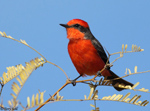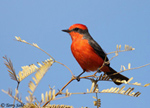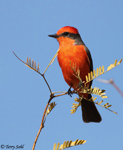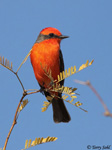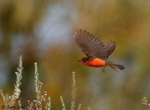| Length: 6 inches | Wingspan: 9.5 inches | Seasonality: Rare Visitor |
| ID Keys: Males nearly unmistakable with brilliant red underparts and head, with darker upperparts. Females primarily gray with lighter underparts. | ||
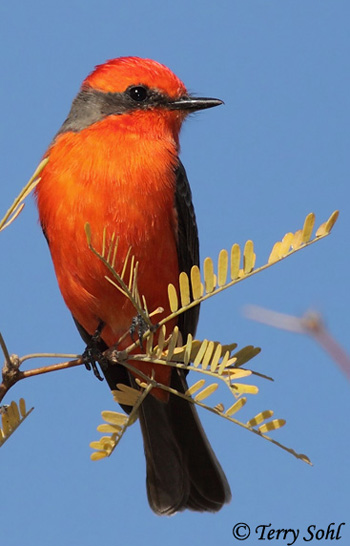 Unlike many North American flycatchers, the male Vermilion
Flycatcher is brilliantly colored, with bright red underparts and head, with
darker upperparts and a dark eye mask (see photo to the right). Females
are much more muted, being primarily gray and white (see photo at the bottom of
the page). Vermilion Flycatchers normally only reach the United States in
the extreme Southwest. Small numbers of birds do winter near the Gulf
Coast, but they only rarely stray as far north as South Dakota. They can
also be found throughout Mexico, and Central and South America. Males
perform a spectacular flight display, puffing themselves up, rising high in the
air, and then fluttering downward again in a process that may repeat itself many
times.
Unlike many North American flycatchers, the male Vermilion
Flycatcher is brilliantly colored, with bright red underparts and head, with
darker upperparts and a dark eye mask (see photo to the right). Females
are much more muted, being primarily gray and white (see photo at the bottom of
the page). Vermilion Flycatchers normally only reach the United States in
the extreme Southwest. Small numbers of birds do winter near the Gulf
Coast, but they only rarely stray as far north as South Dakota. They can
also be found throughout Mexico, and Central and South America. Males
perform a spectacular flight display, puffing themselves up, rising high in the
air, and then fluttering downward again in a process that may repeat itself many
times.
Habitat: Generally found in open country with scattered trees, normally near rivers, streams, and lakes. They may also occasionally be found in grassland or desert areas far from water.
Diet: Feeds exclusively on insects.
Behavior: Forages by observing from a perch, and flying out to capture insects when spotted, either catching them in mid-air, or pouncing on them on the ground or in foliage.
Breeding: Non-breeder in South Dakota. In their breeding range, the nest is a small cup, constructed of twigs, grasses, tree bark, and other material, lined with softer and finer material such as hair, down, or fine grasses. It is placed on a tree branch, anywhere from 6 to 30 feet off the ground. The female lays 2 to 4 eggs, and she alone incubates them. The young hatch after about two weeks, and fledge from the nest in another 12-14 days.
Song: The song is a high, fluttering series of rising and falling notes, often given while in flight.
Migration: Generally a permanent resident throughout most of its range, although some birds at the northern end of its range (southwestern U.S.) may move southward or to lower elevations in the winter.
Interactive eBird map: Click here to access an interactive eBird map of Vermilion Flycatcher sightings
Similar Species: Scarlet Tanager
Conservation Status: Surveys have shown declines in population over recent decades. However, overall populations don't appear to be threatened. The IUCN considers the Vermilion Flycatcher to be a species of "Least Concern".
Further Information: 1) USGS Patuxent Bird Identification InfoCenter, Vermilion Flycatcher.
2) Audubon Guide - Vermilion Flycatcher
3) WhatBird - Vermilion Flycatcher
Photo Information: December 9th, 2010 - Near Chandler, Arizona - Terry Sohl
| Click on the map below for a higher-resolution view |
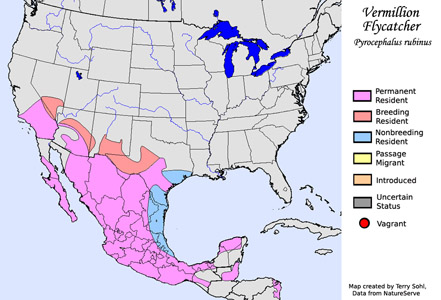 |
| South Dakota Status: Extremely rare visitor, with only a handful of records in the state. |
Additional Vermilion Flycatcher Photos
Click for a higher-resolution version of these photos
